HI6007 Statistics for Business Decisions: Tutorial Questions Analysis
VerifiedAdded on 2023/01/11
|10
|1949
|85
Homework Assignment
AI Summary
This document presents a comprehensive solution to a statistics for business assignment, addressing various tutorial questions related to data analysis and statistical concepts. The solution begins with an introduction to statistics and then explores the differences between sample statistics and populat...
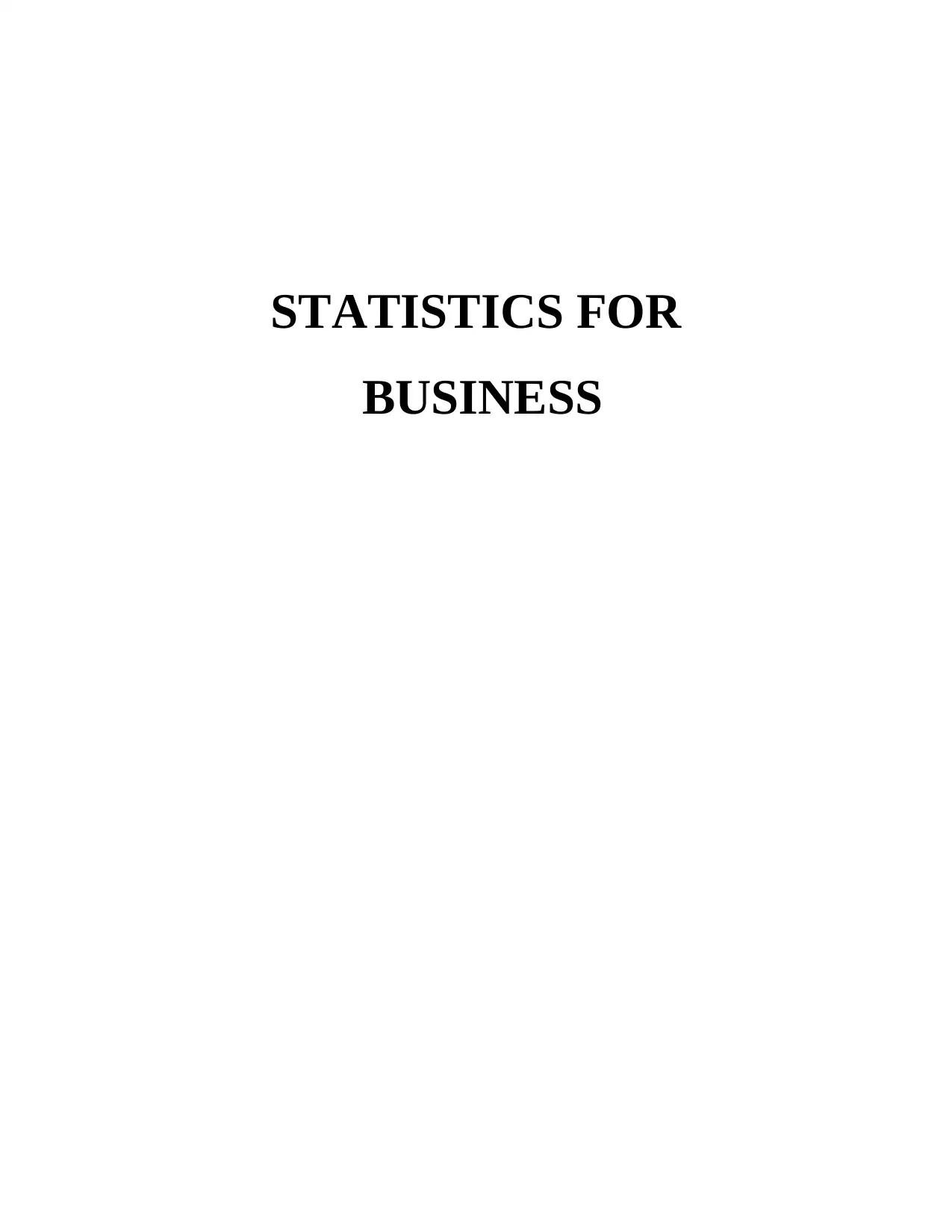
STATISTICS FOR
BUSINESS
BUSINESS
Paraphrase This Document
Need a fresh take? Get an instant paraphrase of this document with our AI Paraphraser
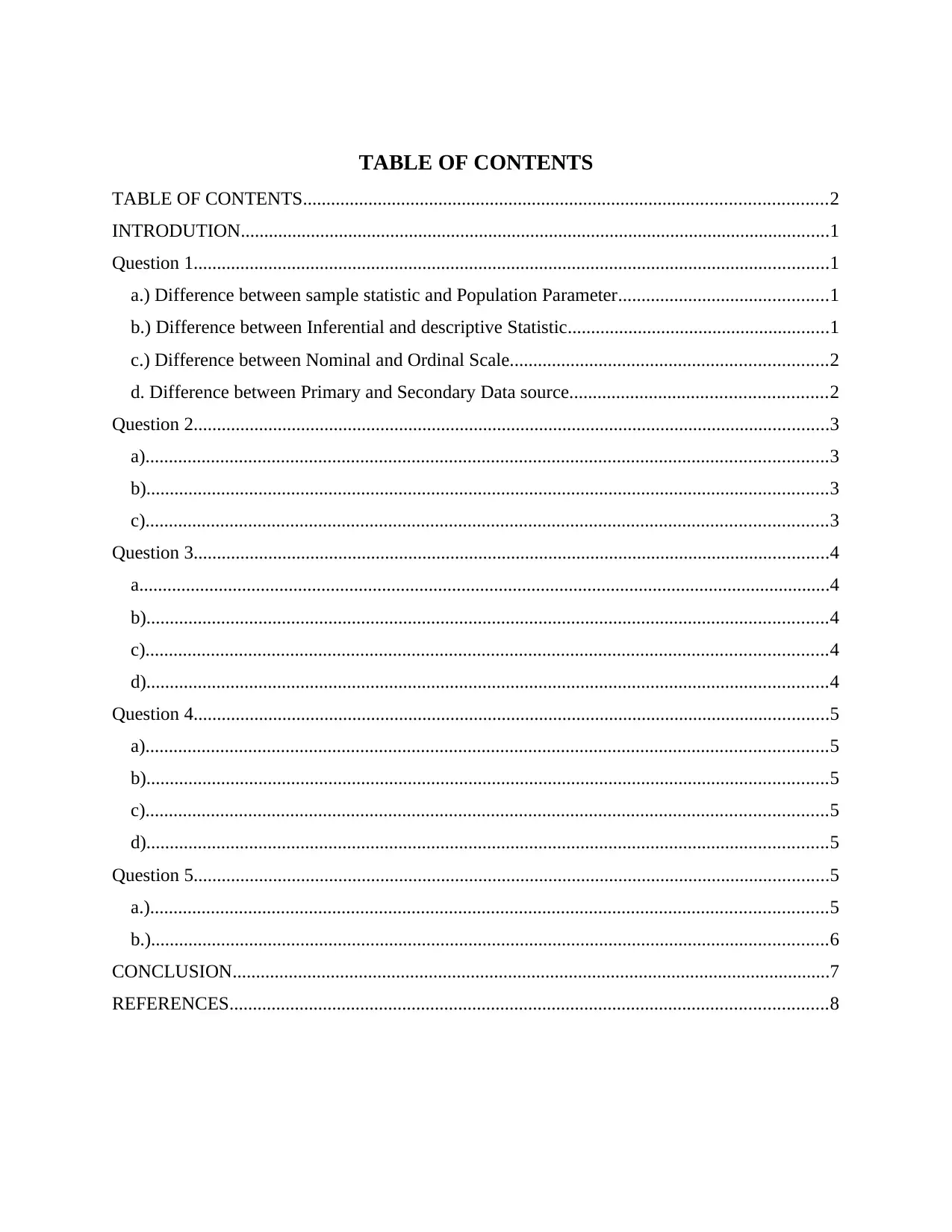
TABLE OF CONTENTS
TABLE OF CONTENTS................................................................................................................2
INTRODUTION..............................................................................................................................1
Question 1........................................................................................................................................1
a.) Difference between sample statistic and Population Parameter.............................................1
b.) Difference between Inferential and descriptive Statistic........................................................1
c.) Difference between Nominal and Ordinal Scale....................................................................2
d. Difference between Primary and Secondary Data source.......................................................2
Question 2........................................................................................................................................3
a)..................................................................................................................................................3
b)..................................................................................................................................................3
c)..................................................................................................................................................3
Question 3........................................................................................................................................4
a....................................................................................................................................................4
b)..................................................................................................................................................4
c)..................................................................................................................................................4
d)..................................................................................................................................................4
Question 4........................................................................................................................................5
a)..................................................................................................................................................5
b)..................................................................................................................................................5
c)..................................................................................................................................................5
d)..................................................................................................................................................5
Question 5........................................................................................................................................5
a.).................................................................................................................................................5
b.).................................................................................................................................................6
CONCLUSION................................................................................................................................7
REFERENCES................................................................................................................................8
TABLE OF CONTENTS................................................................................................................2
INTRODUTION..............................................................................................................................1
Question 1........................................................................................................................................1
a.) Difference between sample statistic and Population Parameter.............................................1
b.) Difference between Inferential and descriptive Statistic........................................................1
c.) Difference between Nominal and Ordinal Scale....................................................................2
d. Difference between Primary and Secondary Data source.......................................................2
Question 2........................................................................................................................................3
a)..................................................................................................................................................3
b)..................................................................................................................................................3
c)..................................................................................................................................................3
Question 3........................................................................................................................................4
a....................................................................................................................................................4
b)..................................................................................................................................................4
c)..................................................................................................................................................4
d)..................................................................................................................................................4
Question 4........................................................................................................................................5
a)..................................................................................................................................................5
b)..................................................................................................................................................5
c)..................................................................................................................................................5
d)..................................................................................................................................................5
Question 5........................................................................................................................................5
a.).................................................................................................................................................5
b.).................................................................................................................................................6
CONCLUSION................................................................................................................................7
REFERENCES................................................................................................................................8
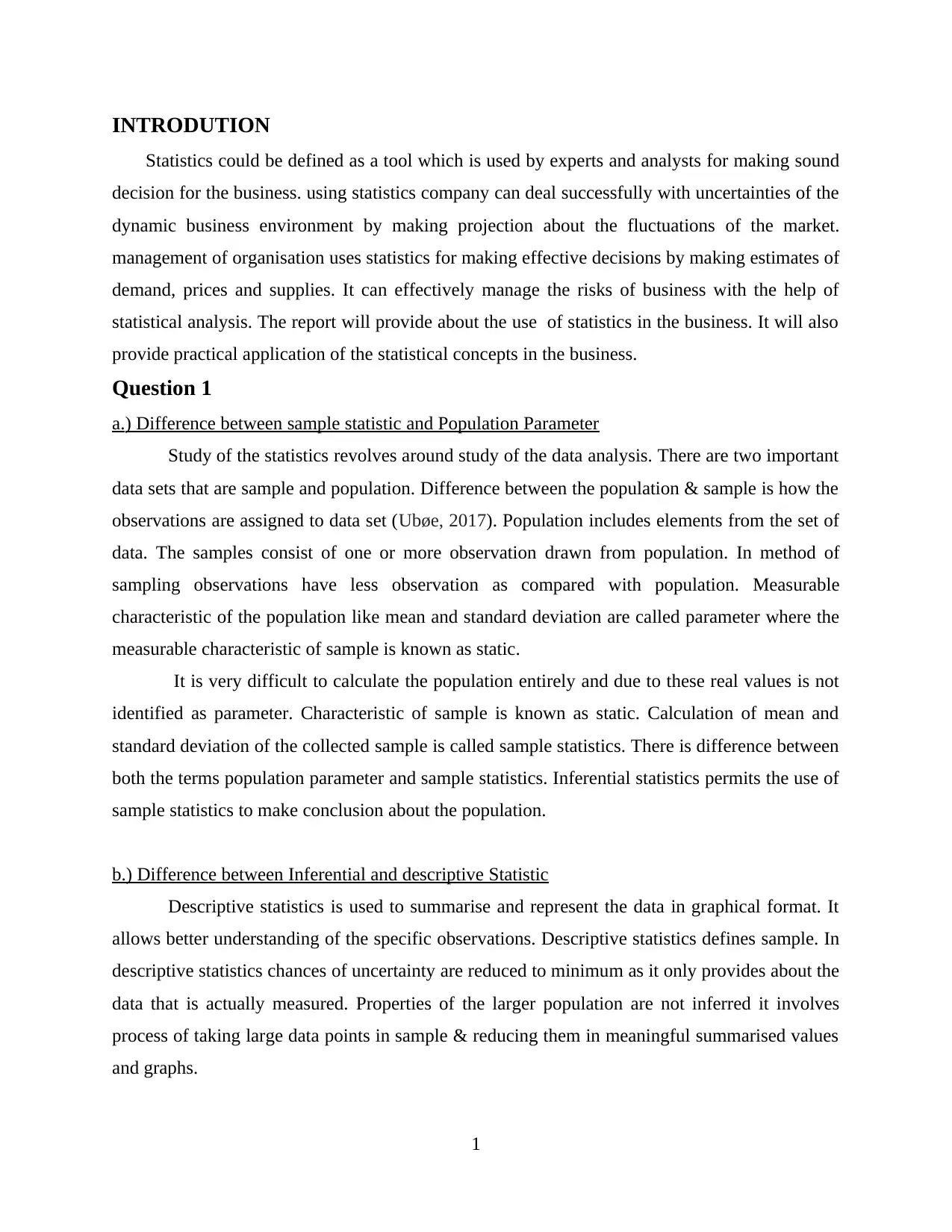
INTRODUTION
Statistics could be defined as a tool which is used by experts and analysts for making sound
decision for the business. using statistics company can deal successfully with uncertainties of the
dynamic business environment by making projection about the fluctuations of the market.
management of organisation uses statistics for making effective decisions by making estimates of
demand, prices and supplies. It can effectively manage the risks of business with the help of
statistical analysis. The report will provide about the use of statistics in the business. It will also
provide practical application of the statistical concepts in the business.
Question 1
a.) Difference between sample statistic and Population Parameter
Study of the statistics revolves around study of the data analysis. There are two important
data sets that are sample and population. Difference between the population & sample is how the
observations are assigned to data set (Ubøe, 2017). Population includes elements from the set of
data. The samples consist of one or more observation drawn from population. In method of
sampling observations have less observation as compared with population. Measurable
characteristic of the population like mean and standard deviation are called parameter where the
measurable characteristic of sample is known as static.
It is very difficult to calculate the population entirely and due to these real values is not
identified as parameter. Characteristic of sample is known as static. Calculation of mean and
standard deviation of the collected sample is called sample statistics. There is difference between
both the terms population parameter and sample statistics. Inferential statistics permits the use of
sample statistics to make conclusion about the population.
b.) Difference between Inferential and descriptive Statistic
Descriptive statistics is used to summarise and represent the data in graphical format. It
allows better understanding of the specific observations. Descriptive statistics defines sample. In
descriptive statistics chances of uncertainty are reduced to minimum as it only provides about the
data that is actually measured. Properties of the larger population are not inferred it involves
process of taking large data points in sample & reducing them in meaningful summarised values
and graphs.
1
Statistics could be defined as a tool which is used by experts and analysts for making sound
decision for the business. using statistics company can deal successfully with uncertainties of the
dynamic business environment by making projection about the fluctuations of the market.
management of organisation uses statistics for making effective decisions by making estimates of
demand, prices and supplies. It can effectively manage the risks of business with the help of
statistical analysis. The report will provide about the use of statistics in the business. It will also
provide practical application of the statistical concepts in the business.
Question 1
a.) Difference between sample statistic and Population Parameter
Study of the statistics revolves around study of the data analysis. There are two important
data sets that are sample and population. Difference between the population & sample is how the
observations are assigned to data set (Ubøe, 2017). Population includes elements from the set of
data. The samples consist of one or more observation drawn from population. In method of
sampling observations have less observation as compared with population. Measurable
characteristic of the population like mean and standard deviation are called parameter where the
measurable characteristic of sample is known as static.
It is very difficult to calculate the population entirely and due to these real values is not
identified as parameter. Characteristic of sample is known as static. Calculation of mean and
standard deviation of the collected sample is called sample statistics. There is difference between
both the terms population parameter and sample statistics. Inferential statistics permits the use of
sample statistics to make conclusion about the population.
b.) Difference between Inferential and descriptive Statistic
Descriptive statistics is used to summarise and represent the data in graphical format. It
allows better understanding of the specific observations. Descriptive statistics defines sample. In
descriptive statistics chances of uncertainty are reduced to minimum as it only provides about the
data that is actually measured. Properties of the larger population are not inferred it involves
process of taking large data points in sample & reducing them in meaningful summarised values
and graphs.
1
⊘ This is a preview!⊘
Do you want full access?
Subscribe today to unlock all pages.

Trusted by 1+ million students worldwide
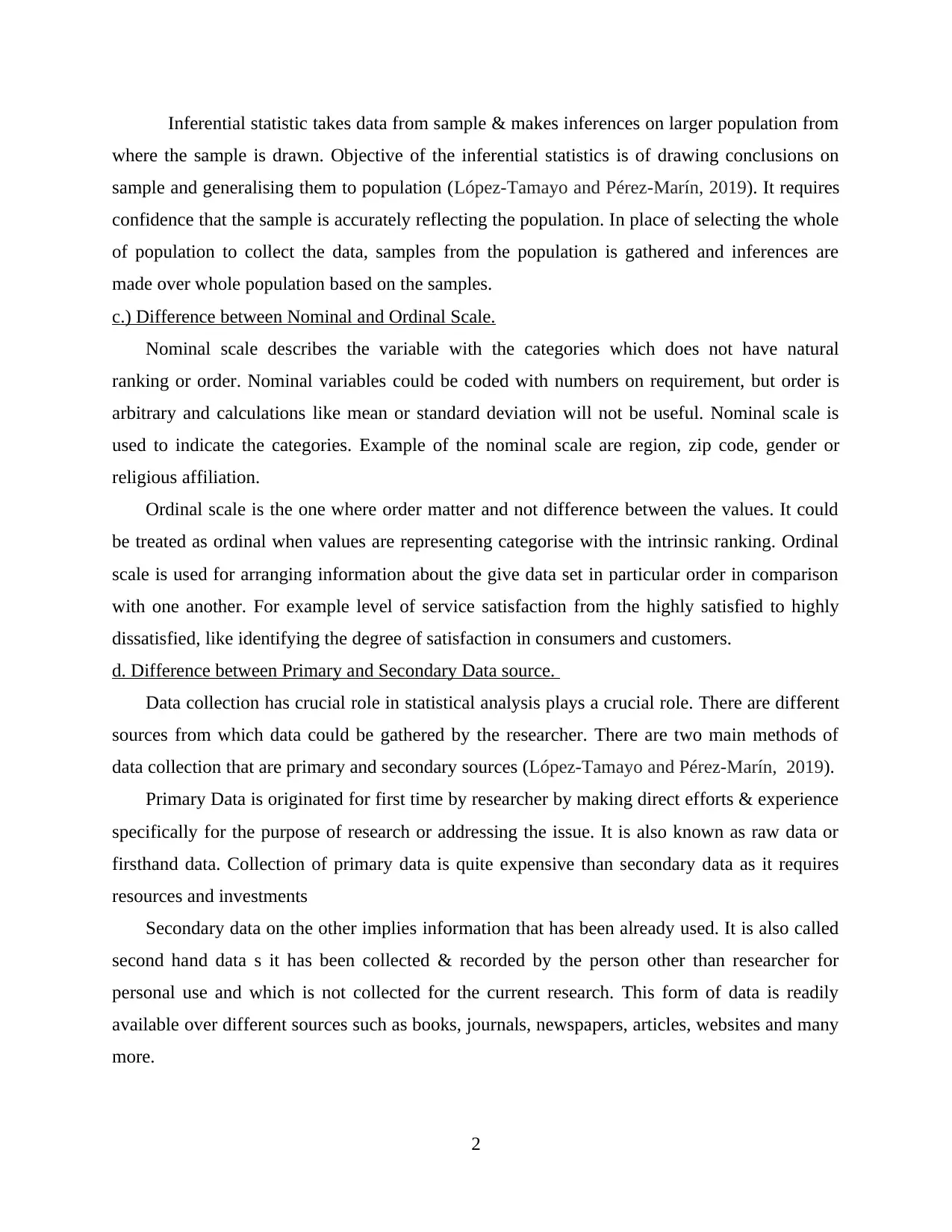
Inferential statistic takes data from sample & makes inferences on larger population from
where the sample is drawn. Objective of the inferential statistics is of drawing conclusions on
sample and generalising them to population (López-Tamayo and Pérez-Marín, 2019). It requires
confidence that the sample is accurately reflecting the population. In place of selecting the whole
of population to collect the data, samples from the population is gathered and inferences are
made over whole population based on the samples.
c.) Difference between Nominal and Ordinal Scale.
Nominal scale describes the variable with the categories which does not have natural
ranking or order. Nominal variables could be coded with numbers on requirement, but order is
arbitrary and calculations like mean or standard deviation will not be useful. Nominal scale is
used to indicate the categories. Example of the nominal scale are region, zip code, gender or
religious affiliation.
Ordinal scale is the one where order matter and not difference between the values. It could
be treated as ordinal when values are representing categorise with the intrinsic ranking. Ordinal
scale is used for arranging information about the give data set in particular order in comparison
with one another. For example level of service satisfaction from the highly satisfied to highly
dissatisfied, like identifying the degree of satisfaction in consumers and customers.
d. Difference between Primary and Secondary Data source.
Data collection has crucial role in statistical analysis plays a crucial role. There are different
sources from which data could be gathered by the researcher. There are two main methods of
data collection that are primary and secondary sources (López-Tamayo and Pérez-Marín, 2019).
Primary Data is originated for first time by researcher by making direct efforts & experience
specifically for the purpose of research or addressing the issue. It is also known as raw data or
firsthand data. Collection of primary data is quite expensive than secondary data as it requires
resources and investments
Secondary data on the other implies information that has been already used. It is also called
second hand data s it has been collected & recorded by the person other than researcher for
personal use and which is not collected for the current research. This form of data is readily
available over different sources such as books, journals, newspapers, articles, websites and many
more.
2
where the sample is drawn. Objective of the inferential statistics is of drawing conclusions on
sample and generalising them to population (López-Tamayo and Pérez-Marín, 2019). It requires
confidence that the sample is accurately reflecting the population. In place of selecting the whole
of population to collect the data, samples from the population is gathered and inferences are
made over whole population based on the samples.
c.) Difference between Nominal and Ordinal Scale.
Nominal scale describes the variable with the categories which does not have natural
ranking or order. Nominal variables could be coded with numbers on requirement, but order is
arbitrary and calculations like mean or standard deviation will not be useful. Nominal scale is
used to indicate the categories. Example of the nominal scale are region, zip code, gender or
religious affiliation.
Ordinal scale is the one where order matter and not difference between the values. It could
be treated as ordinal when values are representing categorise with the intrinsic ranking. Ordinal
scale is used for arranging information about the give data set in particular order in comparison
with one another. For example level of service satisfaction from the highly satisfied to highly
dissatisfied, like identifying the degree of satisfaction in consumers and customers.
d. Difference between Primary and Secondary Data source.
Data collection has crucial role in statistical analysis plays a crucial role. There are different
sources from which data could be gathered by the researcher. There are two main methods of
data collection that are primary and secondary sources (López-Tamayo and Pérez-Marín, 2019).
Primary Data is originated for first time by researcher by making direct efforts & experience
specifically for the purpose of research or addressing the issue. It is also known as raw data or
firsthand data. Collection of primary data is quite expensive than secondary data as it requires
resources and investments
Secondary data on the other implies information that has been already used. It is also called
second hand data s it has been collected & recorded by the person other than researcher for
personal use and which is not collected for the current research. This form of data is readily
available over different sources such as books, journals, newspapers, articles, websites and many
more.
2
Paraphrase This Document
Need a fresh take? Get an instant paraphrase of this document with our AI Paraphraser
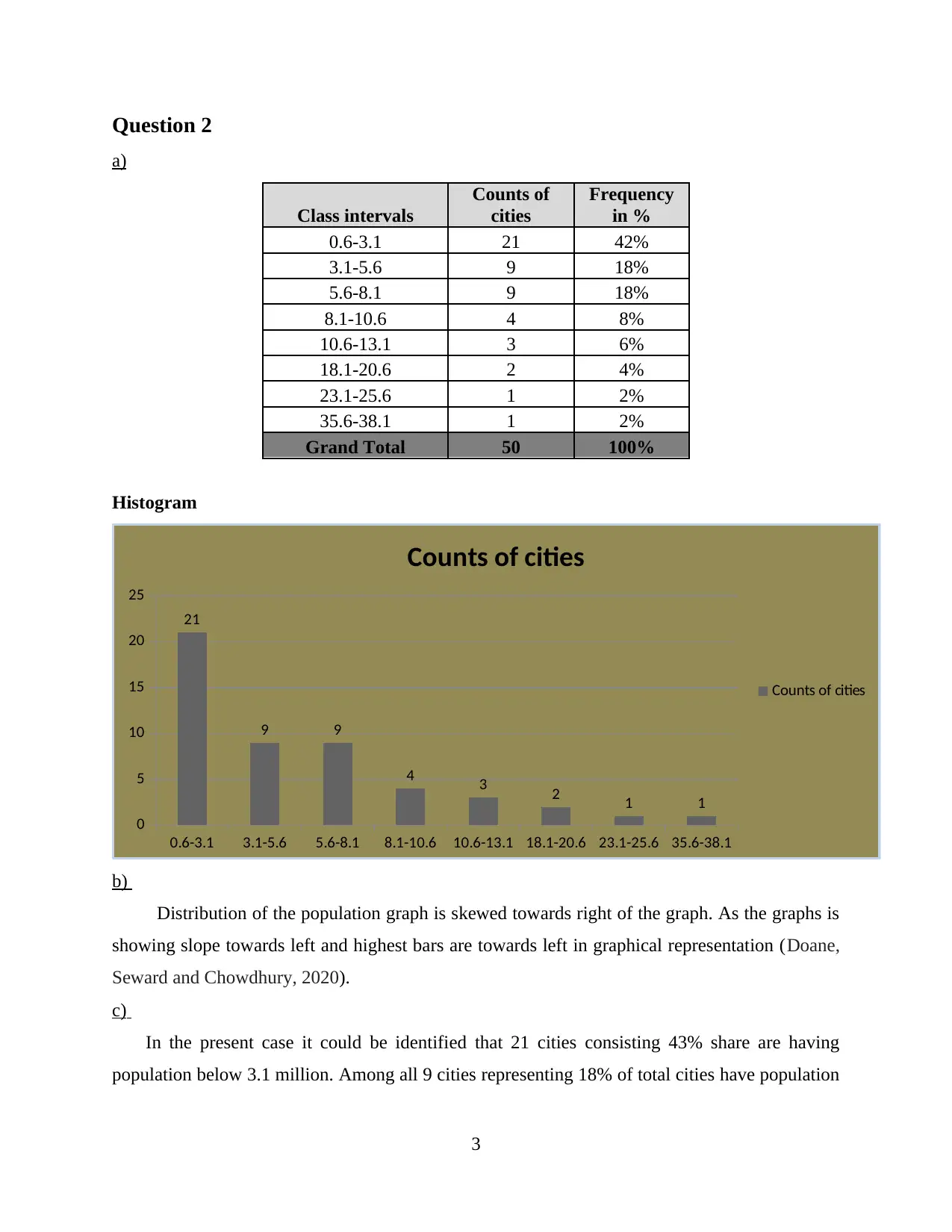
Question 2
a)
Class intervals
Counts of
cities
Frequency
in %
0.6-3.1 21 42%
3.1-5.6 9 18%
5.6-8.1 9 18%
8.1-10.6 4 8%
10.6-13.1 3 6%
18.1-20.6 2 4%
23.1-25.6 1 2%
35.6-38.1 1 2%
Grand Total 50 100%
Histogram
0.6-3.1 3.1-5.6 5.6-8.1 8.1-10.6 10.6-13.1 18.1-20.6 23.1-25.6 35.6-38.1
0
5
10
15
20
25
21
9 9
4 3 2 1 1
Counts of cities
Counts of cities
b)
Distribution of the population graph is skewed towards right of the graph. As the graphs is
showing slope towards left and highest bars are towards left in graphical representation (Doane,
Seward and Chowdhury, 2020).
c)
In the present case it could be identified that 21 cities consisting 43% share are having
population below 3.1 million. Among all 9 cities representing 18% of total cities have population
3
a)
Class intervals
Counts of
cities
Frequency
in %
0.6-3.1 21 42%
3.1-5.6 9 18%
5.6-8.1 9 18%
8.1-10.6 4 8%
10.6-13.1 3 6%
18.1-20.6 2 4%
23.1-25.6 1 2%
35.6-38.1 1 2%
Grand Total 50 100%
Histogram
0.6-3.1 3.1-5.6 5.6-8.1 8.1-10.6 10.6-13.1 18.1-20.6 23.1-25.6 35.6-38.1
0
5
10
15
20
25
21
9 9
4 3 2 1 1
Counts of cities
Counts of cities
b)
Distribution of the population graph is skewed towards right of the graph. As the graphs is
showing slope towards left and highest bars are towards left in graphical representation (Doane,
Seward and Chowdhury, 2020).
c)
In the present case it could be identified that 21 cities consisting 43% share are having
population below 3.1 million. Among all 9 cities representing 18% of total cities have population
3
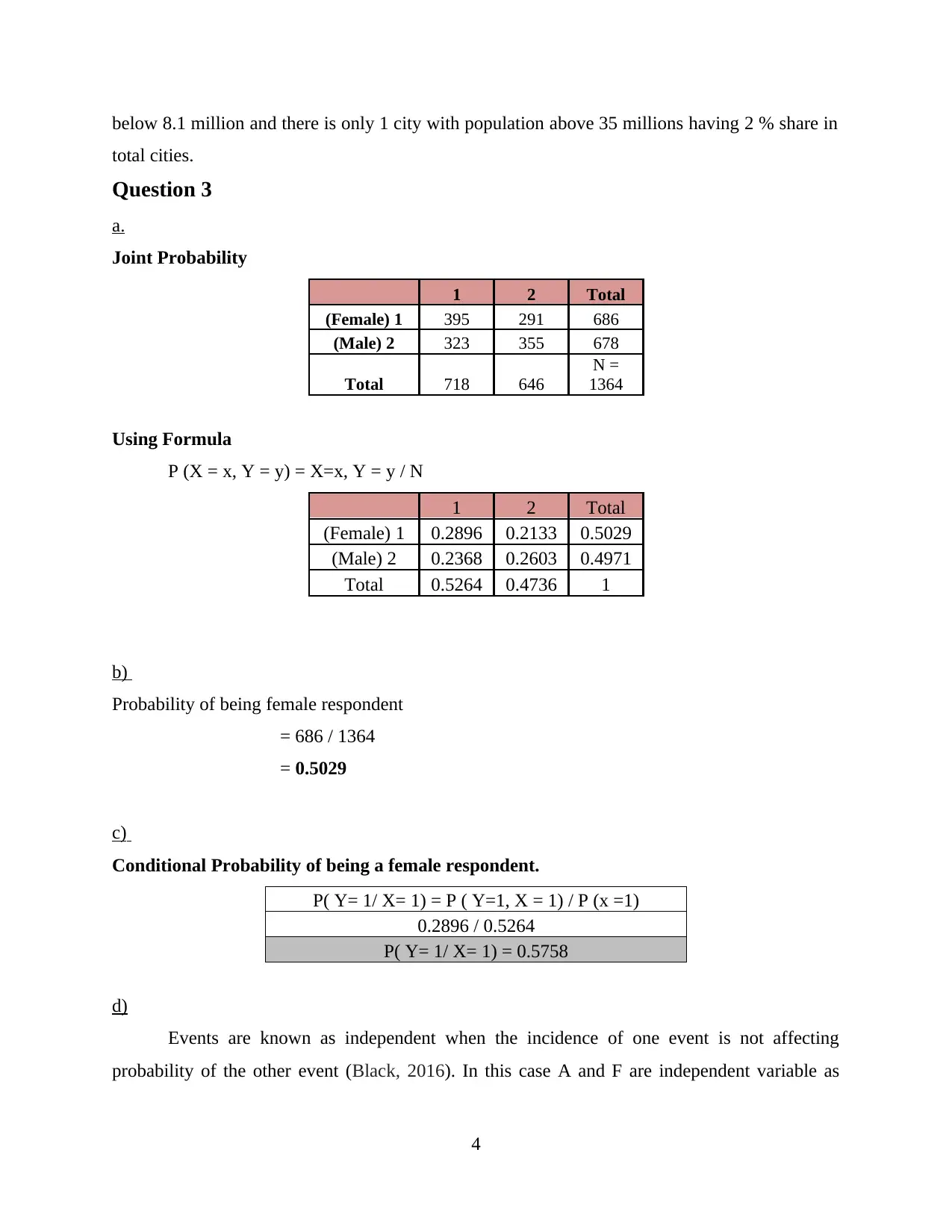
below 8.1 million and there is only 1 city with population above 35 millions having 2 % share in
total cities.
Question 3
a.
Joint Probability
1 2 Total
(Female) 1 395 291 686
(Male) 2 323 355 678
Total 718 646
N =
1364
Using Formula
P (X = x, Y = y) = X=x, Y = y / N
1 2 Total
(Female) 1 0.2896 0.2133 0.5029
(Male) 2 0.2368 0.2603 0.4971
Total 0.5264 0.4736 1
b)
Probability of being female respondent
= 686 / 1364
= 0.5029
c)
Conditional Probability of being a female respondent.
P( Y= 1/ X= 1) = P ( Y=1, X = 1) / P (x =1)
0.2896 / 0.5264
P( Y= 1/ X= 1) = 0.5758
d)
Events are known as independent when the incidence of one event is not affecting
probability of the other event (Black, 2016). In this case A and F are independent variable as
4
total cities.
Question 3
a.
Joint Probability
1 2 Total
(Female) 1 395 291 686
(Male) 2 323 355 678
Total 718 646
N =
1364
Using Formula
P (X = x, Y = y) = X=x, Y = y / N
1 2 Total
(Female) 1 0.2896 0.2133 0.5029
(Male) 2 0.2368 0.2603 0.4971
Total 0.5264 0.4736 1
b)
Probability of being female respondent
= 686 / 1364
= 0.5029
c)
Conditional Probability of being a female respondent.
P( Y= 1/ X= 1) = P ( Y=1, X = 1) / P (x =1)
0.2896 / 0.5264
P( Y= 1/ X= 1) = 0.5758
d)
Events are known as independent when the incidence of one event is not affecting
probability of the other event (Black, 2016). In this case A and F are independent variable as
4
⊘ This is a preview!⊘
Do you want full access?
Subscribe today to unlock all pages.

Trusted by 1+ million students worldwide
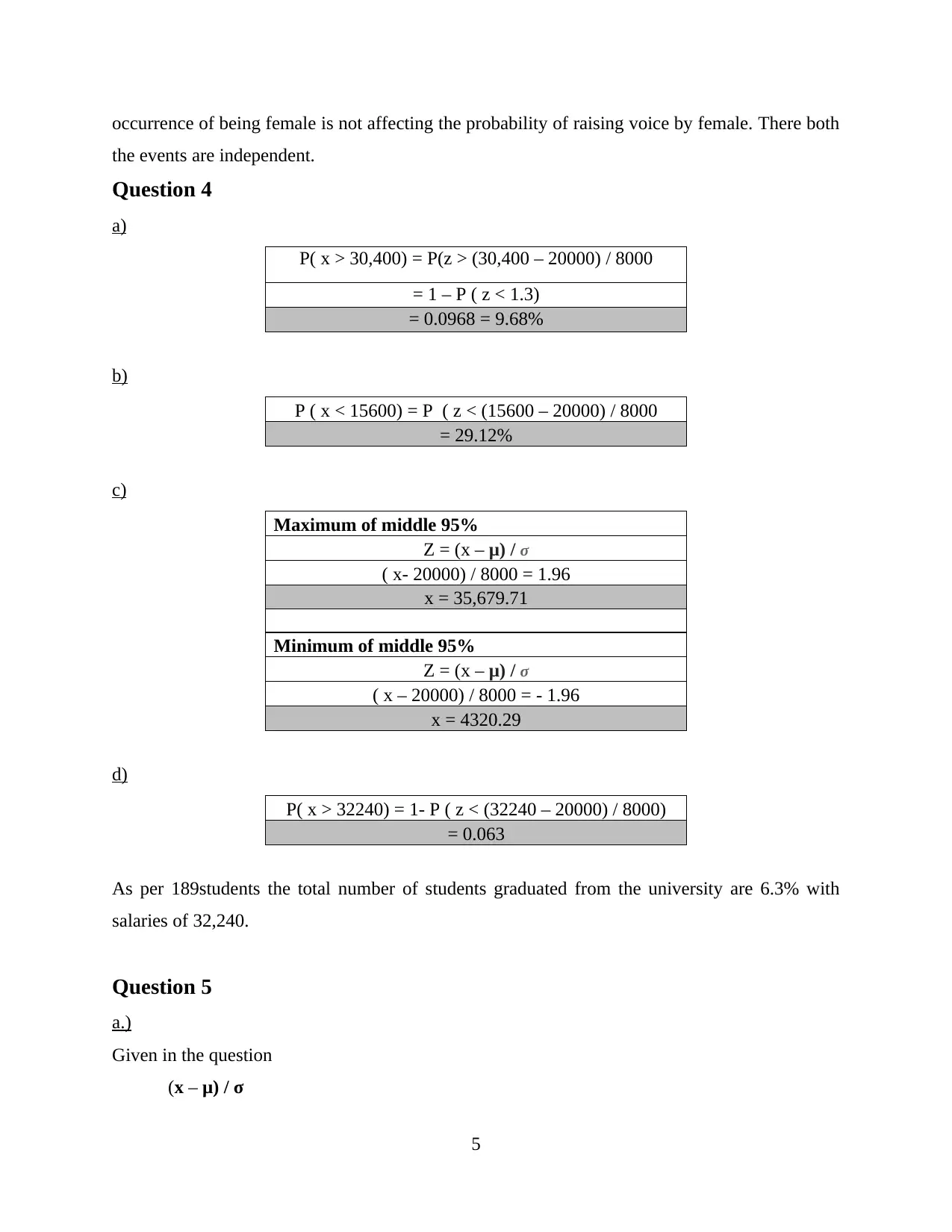
occurrence of being female is not affecting the probability of raising voice by female. There both
the events are independent.
Question 4
a)
P( x > 30,400) = P(z > (30,400 – 20000) / 8000
= 1 – P ( z < 1.3)
= 0.0968 = 9.68%
b)
P ( x < 15600) = P ( z < (15600 – 20000) / 8000
= 29.12%
c)
Maximum of middle 95%
Z = (x – μ) / σ
( x- 20000) / 8000 = 1.96
x = 35,679.71
Minimum of middle 95%
Z = (x – μ) / σ
( x – 20000) / 8000 = - 1.96
x = 4320.29
d)
P( x > 32240) = 1- P ( z < (32240 – 20000) / 8000)
= 0.063
As per 189students the total number of students graduated from the university are 6.3% with
salaries of 32,240.
Question 5
a.)
Given in the question
(x – μ) / σ
5
the events are independent.
Question 4
a)
P( x > 30,400) = P(z > (30,400 – 20000) / 8000
= 1 – P ( z < 1.3)
= 0.0968 = 9.68%
b)
P ( x < 15600) = P ( z < (15600 – 20000) / 8000
= 29.12%
c)
Maximum of middle 95%
Z = (x – μ) / σ
( x- 20000) / 8000 = 1.96
x = 35,679.71
Minimum of middle 95%
Z = (x – μ) / σ
( x – 20000) / 8000 = - 1.96
x = 4320.29
d)
P( x > 32240) = 1- P ( z < (32240 – 20000) / 8000)
= 0.063
As per 189students the total number of students graduated from the university are 6.3% with
salaries of 32,240.
Question 5
a.)
Given in the question
(x – μ) / σ
5
Paraphrase This Document
Need a fresh take? Get an instant paraphrase of this document with our AI Paraphraser
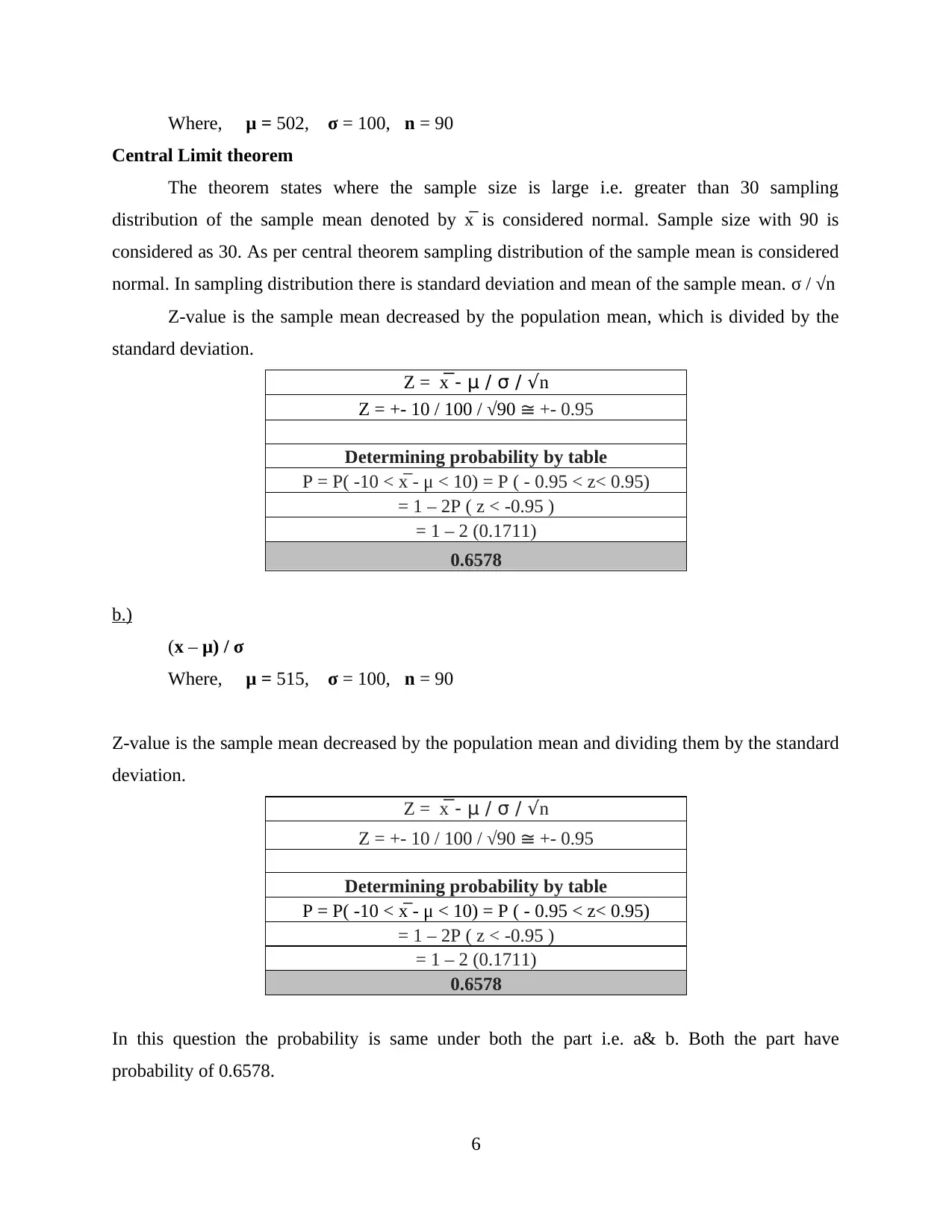
Where, μ = 502, σ = 100, n = 90
Central Limit theorem
The theorem states where the sample size is large i.e. greater than 30 sampling
distribution of the sample mean denoted by x̅ is considered normal. Sample size with 90 is
considered as 30. As per central theorem sampling distribution of the sample mean is considered
normal. In sampling distribution there is standard deviation and mean of the sample mean. σ / √n
Z-value is the sample mean decreased by the population mean, which is divided by the
standard deviation.
Z = x̅ - μ / σ / √n
Z = +- 10 / 100 / √90 ≅ +- 0.95
Determining probability by table
P = P( -10 < x̅ - μ < 10) = P ( - 0.95 < z< 0.95)
= 1 – 2P ( z < -0.95 )
= 1 – 2 (0.1711)
0.6578
b.)
(x – μ) / σ
Where, μ = 515, σ = 100, n = 90
Z-value is the sample mean decreased by the population mean and dividing them by the standard
deviation.
Z = x̅ - μ / σ / √n
Z = +- 10 / 100 / √90 ≅ +- 0.95
Determining probability by table
P = P( -10 < x̅ - μ < 10) = P ( - 0.95 < z< 0.95)
= 1 – 2P ( z < -0.95 )
= 1 – 2 (0.1711)
0.6578
In this question the probability is same under both the part i.e. a& b. Both the part have
probability of 0.6578.
6
Central Limit theorem
The theorem states where the sample size is large i.e. greater than 30 sampling
distribution of the sample mean denoted by x̅ is considered normal. Sample size with 90 is
considered as 30. As per central theorem sampling distribution of the sample mean is considered
normal. In sampling distribution there is standard deviation and mean of the sample mean. σ / √n
Z-value is the sample mean decreased by the population mean, which is divided by the
standard deviation.
Z = x̅ - μ / σ / √n
Z = +- 10 / 100 / √90 ≅ +- 0.95
Determining probability by table
P = P( -10 < x̅ - μ < 10) = P ( - 0.95 < z< 0.95)
= 1 – 2P ( z < -0.95 )
= 1 – 2 (0.1711)
0.6578
b.)
(x – μ) / σ
Where, μ = 515, σ = 100, n = 90
Z-value is the sample mean decreased by the population mean and dividing them by the standard
deviation.
Z = x̅ - μ / σ / √n
Z = +- 10 / 100 / √90 ≅ +- 0.95
Determining probability by table
P = P( -10 < x̅ - μ < 10) = P ( - 0.95 < z< 0.95)
= 1 – 2P ( z < -0.95 )
= 1 – 2 (0.1711)
0.6578
In this question the probability is same under both the part i.e. a& b. Both the part have
probability of 0.6578.
6

CONCLUSION
It could be summarised from the above study that business with the help of statistics can
make sound decisions. It enables them to make accurate estimates about the future trends. It
helps the business in effective planning. Organisations make investment decision by making
probability analysis that prevents the company to make investments in unproductive projects.
Using statistical analysis organisations are achieving growth and success.
7
It could be summarised from the above study that business with the help of statistics can
make sound decisions. It enables them to make accurate estimates about the future trends. It
helps the business in effective planning. Organisations make investment decision by making
probability analysis that prevents the company to make investments in unproductive projects.
Using statistical analysis organisations are achieving growth and success.
7
⊘ This is a preview!⊘
Do you want full access?
Subscribe today to unlock all pages.

Trusted by 1+ million students worldwide
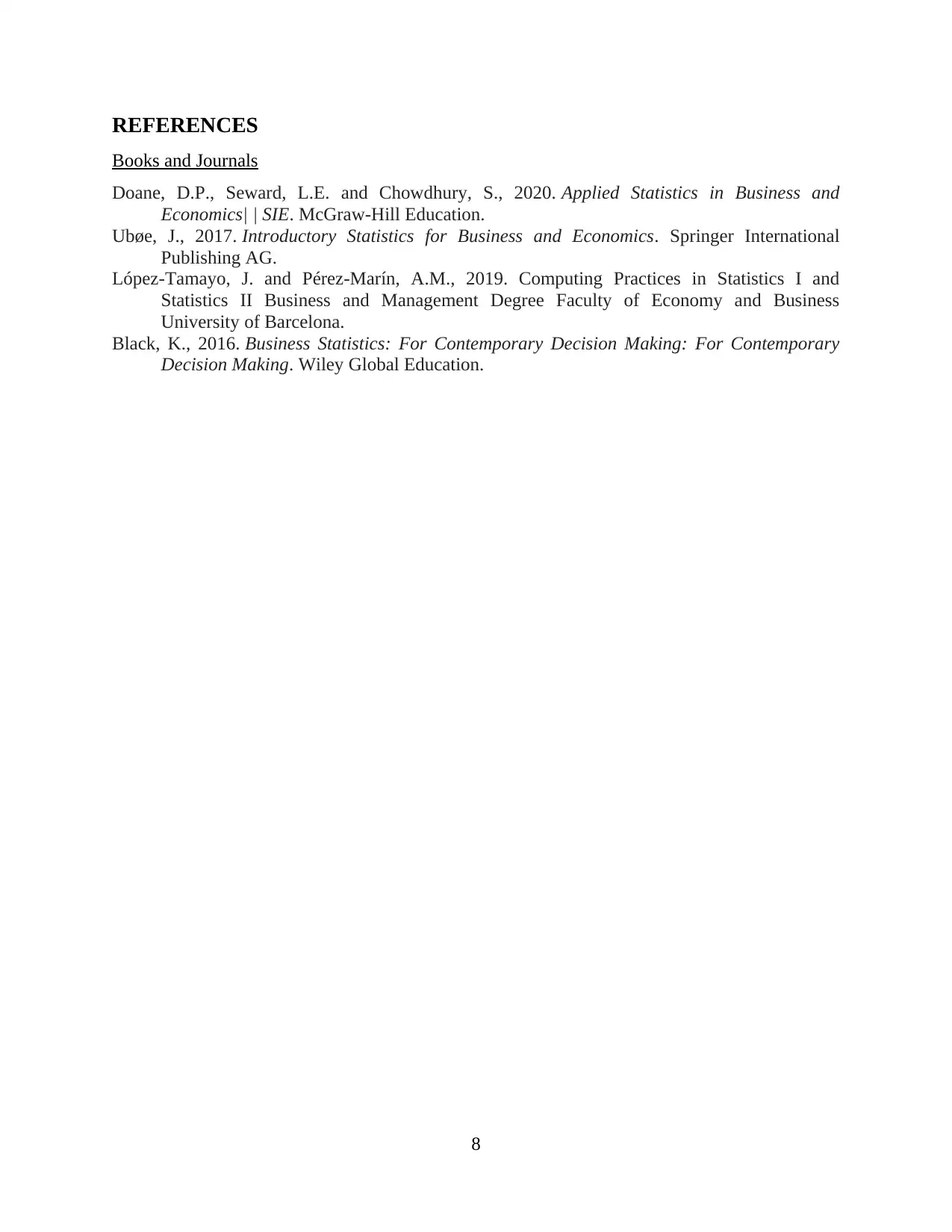
REFERENCES
Books and Journals
Doane, D.P., Seward, L.E. and Chowdhury, S., 2020. Applied Statistics in Business and
Economics| | SIE. McGraw-Hill Education.
Ubøe, J., 2017. Introductory Statistics for Business and Economics. Springer International
Publishing AG.
López-Tamayo, J. and Pérez-Marín, A.M., 2019. Computing Practices in Statistics I and
Statistics II Business and Management Degree Faculty of Economy and Business
University of Barcelona.
Black, K., 2016. Business Statistics: For Contemporary Decision Making: For Contemporary
Decision Making. Wiley Global Education.
8
Books and Journals
Doane, D.P., Seward, L.E. and Chowdhury, S., 2020. Applied Statistics in Business and
Economics| | SIE. McGraw-Hill Education.
Ubøe, J., 2017. Introductory Statistics for Business and Economics. Springer International
Publishing AG.
López-Tamayo, J. and Pérez-Marín, A.M., 2019. Computing Practices in Statistics I and
Statistics II Business and Management Degree Faculty of Economy and Business
University of Barcelona.
Black, K., 2016. Business Statistics: For Contemporary Decision Making: For Contemporary
Decision Making. Wiley Global Education.
8
1 out of 10
Related Documents
Your All-in-One AI-Powered Toolkit for Academic Success.
+13062052269
info@desklib.com
Available 24*7 on WhatsApp / Email
![[object Object]](/_next/static/media/star-bottom.7253800d.svg)
Unlock your academic potential
© 2024 | Zucol Services PVT LTD | All rights reserved.




